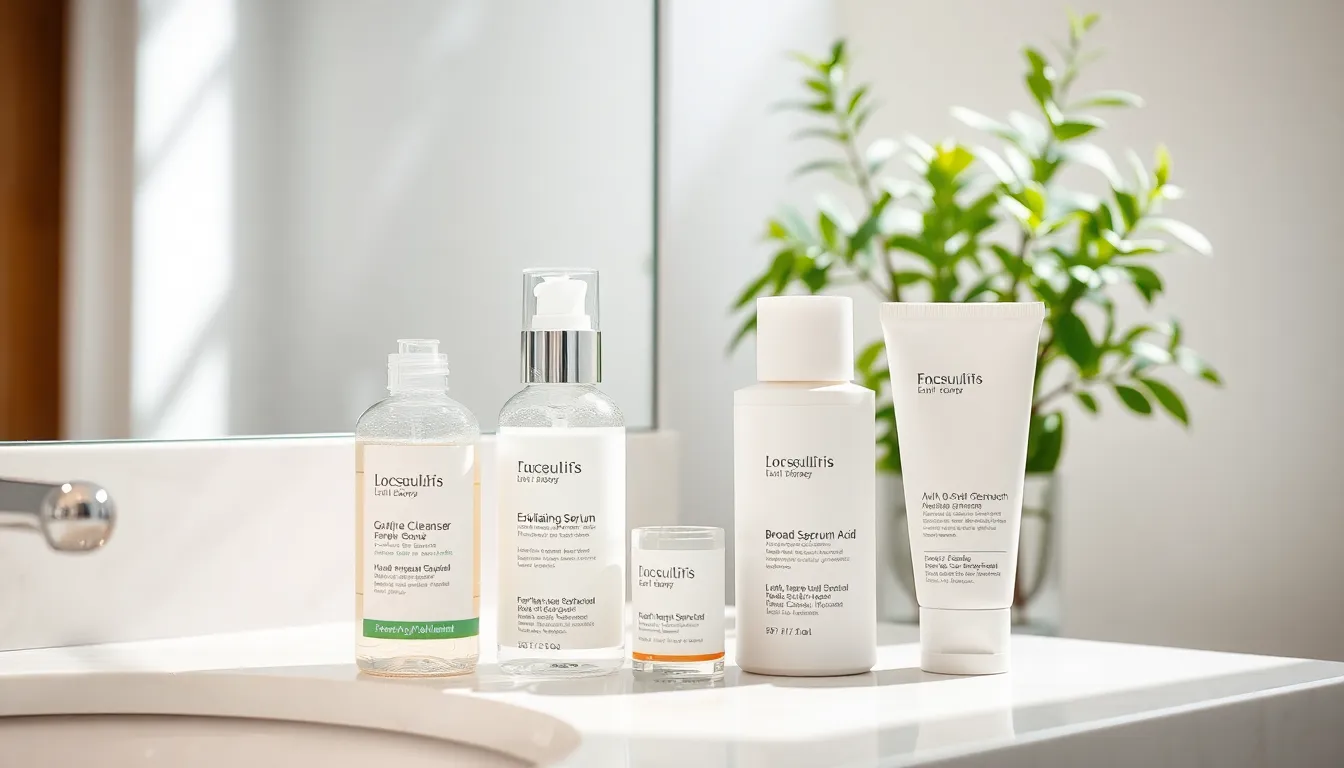Aging is a natural process, but that doesn’t mean one has to accept the visible signs that come with it. With the right anti-aging skincare routine, anyone can maintain a youthful glow and boost their skin’s resilience. As more people seek to defy time, understanding the essential steps and products becomes crucial.
From serums packed with antioxidants to moisturizers that lock in hydration, the options are endless. Tailoring a routine that suits individual skin types and concerns can make all the difference. Discovering effective ingredients and techniques not only enhances appearance but also fosters confidence and self-care. Embracing an anti-aging regimen can transform not just skin, but the way one feels about themselves.
Table of Contents
ToggleUnderstanding Anti-Aging Skin Care
Anti-aging skin care focuses on slowing down the visible effects of aging while enhancing the skin’s overall health. Knowing the underlying factors that contribute to skin aging helps individuals choose effective products and routines.
The Science Behind Aging Skin
Aging skin results from a combination of intrinsic and extrinsic factors. Intrinsic aging, determined by genetics and hormonal changes, typically manifests as a thinning epidermis and reduced collagen production. Extrinsic aging, influenced by environmental factors like UV exposure and pollution, accelerates collagen breakdown and contributes to uneven pigmentation. Notably, decreased elasticity and moisture retention further exacerbate the appearance of fine lines and wrinkles.
Common Signs of Aging
Typical signs of aging skin include:
- Fine Lines: Often appear around the eyes and mouth, signifying reduced elasticity.
- Wrinkles: Deeper creases form from repetitive facial expressions and loss of collagen.
- Sagging: Skin loses firmness due to decreased elastin and collagen, resulting in a less youthful contour.
- Uneven Skin Tone: Sun exposure leads to hyperpigmentation, causing dark spots and discoloration.
- Dryness: Reduced oil production can result in a rough texture and lack of moisture.
- Larger Pores: Collagen loss can make pores appear more prominent, impacting skin texture.
Understanding these signs informs the development of a tailored anti-aging skincare regimen.
Essential Components of an Anti-Aging Skincare Routine

An effective anti-aging skincare routine includes several critical components designed to combat the visible signs of aging. Following these foundational steps ensures the skin remains healthy and resilient over time.
Cleansing and Exfoliating
Cleansing removes dirt, oil, and impurities that accumulate on the skin. A gentle cleanser suited for specific skin types promotes a clean canvas essential for other products in the routine. Exfoliating aids in sloughing off dead skin cells, enhancing skin texture and luminosity. Incorporating chemical exfoliants, such as alpha-hydroxy acids (AHAs) or beta-hydroxy acids (BHAs), two to three times a week encourages cell turnover and helps diminish the appearance of fine lines and uneven tone.
Moisturizing and Hydration
Moisturizing maintains the skin’s hydration balance. A nourishing moisturizer containing ingredients like hyaluronic acid and ceramides promotes skin elasticity and plumpness. Hydration is crucial, as it creates a barrier that locks in moisture and protects against environmental stressors. For increased effectiveness, layering a hydrating serum beneath the moisturizer enhances absorption and impact.
Sun Protection
Daily sun protection is vital in any anti-aging skincare routine. Broad-spectrum sunscreen with a minimum sun protection factor (SPF) of 30 shields the skin from harmful UVA and UVB rays. Regular use of sunscreen helps prevent sun damage, which contributes significantly to premature aging. Reapplying sunscreen every two hours, especially during outdoor activities, ensures continued protection against UV exposure.
Key Ingredients for Anti-Aging
Effective anti-aging skincare relies on powerful ingredients that combat various signs of aging. Key components can significantly enhance skin appearance and health.
Retinoids
Retinoids, derivatives of vitamin A, reduce fine lines and wrinkles by promoting collagen production and skin cell turnover. Different types include retinol, retinaldehyde, and prescription-strength tretinoin. For optimal results, individuals should start with lower concentrations to minimize irritation, gradually increasing usage as their skin builds tolerance. Incorporating retinoids at night enhances their efficacy without sun sensitivity.
Antioxidants
Antioxidants protect skin from environmental damage by neutralizing free radicals. Vitamin C, vitamin E, and ferulic acid are notable examples that brighten skin tone and improve elasticity. Regular application of antioxidant serums aids in reducing the appearance of age spots and promotes an even complexion. Combining multiple antioxidants can enhance overall skin benefits, offering comprehensive protection.
Peptides
Peptides consist of short chains of amino acids that stimulate collagen synthesis and improve skin barrier function. Common peptides include palmitoyl pentapeptide and acetyl hexapeptide-8. Incorporating peptide-infused products enhances skin firmness and reduces sagging. Regular use can lead to visibly smoother skin and improved hydration levels.
Tips for an Effective Anti-Aging Routine
Establishing a consistent and adaptive skincare routine significantly enhances the effectiveness of any anti-aging regimen. The following tips provide essential guidance for creating a personalized routine.
Consistency is Key
Consistency plays a crucial role in achieving visible results in an anti-aging skincare routine. Regular application of products ensures that active ingredients work effectively over time. Establishing a daily routine includes:
- Cleansing: Clean skin allows for optimal absorption of subsequent products. Use gentle cleansers twice a day.
- Exfoliating: Exfoliate 2-3 times weekly with chemical exfoliants like AHAs or BHAs for improved skin texture.
- Moisturizing: Apply a hydrating moisturizer daily to lock in moisture and maintain skin elasticity.
- Sun protection: Utilize broad-spectrum sunscreen every morning, even on cloudy days, to prevent harmful UV damage.
Maintaining this regimen consistently fosters long-term benefits, leading to healthier, more resilient skin.
Adjusting Your Routine with Age
As skin ages, changes in its texture, tone, and moisture levels prompt the need for routine adjustments. Key considerations for modifying an anti-aging routine include:
- Increased hydration: As skin becomes drier, incorporate richer moisturizers with emollients and occlusives.
- Higher potency treatments: Introduce stronger retinoids to address deeper wrinkles and improve skin texture as tolerance builds.
- Enhanced sun protection: Opt for SPF 30 or higher; consider products with additional antioxidants for extra skin protection.
- Targeted treatments: Incorporate serums that focus on specific concerns, like sagging or pigmentation, to better address individual skin needs.
Adapting the routine according to age-specific skin conditions helps maintain a youthful appearance and addresses emerging concerns effectively.
Embracing an anti-aging skincare routine can empower individuals to take control of their skin’s health and appearance. By understanding the factors that contribute to aging and incorporating effective products and techniques, they can significantly enhance their skin’s resilience and vitality.
Consistency is key in achieving lasting results. Tailoring routines to meet specific skin needs ensures that each step contributes to a more youthful and radiant complexion. With the right approach and commitment, anyone can transform their skincare journey and boost their confidence. The path to healthier skin starts with informed choices and a dedication to self-care.


